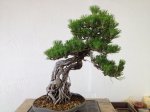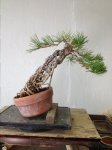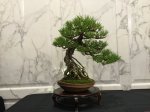Grimmy,
Many beginners to bonsai hear the word "nebari", and find out it means "surface roots", and get confused thinking that "exposed roots" equates to nebari, and they don't have enough experience to know how to tell "good nebari" from "bad nebari".
The tree presented had a lot of "air roots". Which are generally considered "bad nebari". Except in the unusual cases, such as the example that I posted.
The tree I posted is a recent import from Japan that someone posted on Facebook. (I don't remember if it was imported to the USA or UK. Doesn't matter.)
That tree is not an "experiment", it is an accepted style. I did describe how to make one.
If you doubt these are relatively abundant, please google "exposed root azalea bonsai", then look at the Images. You will see many examples.
Here are a couple that are not azalea:



By the way, I do not subscribe to the "Naturalistic School" of bonsai as advocated by Walter Pall and others. I prefer more highly refined bonsai. I will agree that some can go overboard on the refinement to the extent the tree looks artificial. Occasionally, some of Bjorn's trees cross that line. I am guilty of the "perfectionist" charge, I strive for perfection, but have yet to achieve it! As a teacher of bonsai technique, I feel it is my duty to attempt to share my knowledge of technique as best I can so that others can be more successful at bonsai.
Many beginners to bonsai hear the word "nebari", and find out it means "surface roots", and get confused thinking that "exposed roots" equates to nebari, and they don't have enough experience to know how to tell "good nebari" from "bad nebari".
The tree presented had a lot of "air roots". Which are generally considered "bad nebari". Except in the unusual cases, such as the example that I posted.
The tree I posted is a recent import from Japan that someone posted on Facebook. (I don't remember if it was imported to the USA or UK. Doesn't matter.)
That tree is not an "experiment", it is an accepted style. I did describe how to make one.
If you doubt these are relatively abundant, please google "exposed root azalea bonsai", then look at the Images. You will see many examples.
Here are a couple that are not azalea:



By the way, I do not subscribe to the "Naturalistic School" of bonsai as advocated by Walter Pall and others. I prefer more highly refined bonsai. I will agree that some can go overboard on the refinement to the extent the tree looks artificial. Occasionally, some of Bjorn's trees cross that line. I am guilty of the "perfectionist" charge, I strive for perfection, but have yet to achieve it! As a teacher of bonsai technique, I feel it is my duty to attempt to share my knowledge of technique as best I can so that others can be more successful at bonsai.





